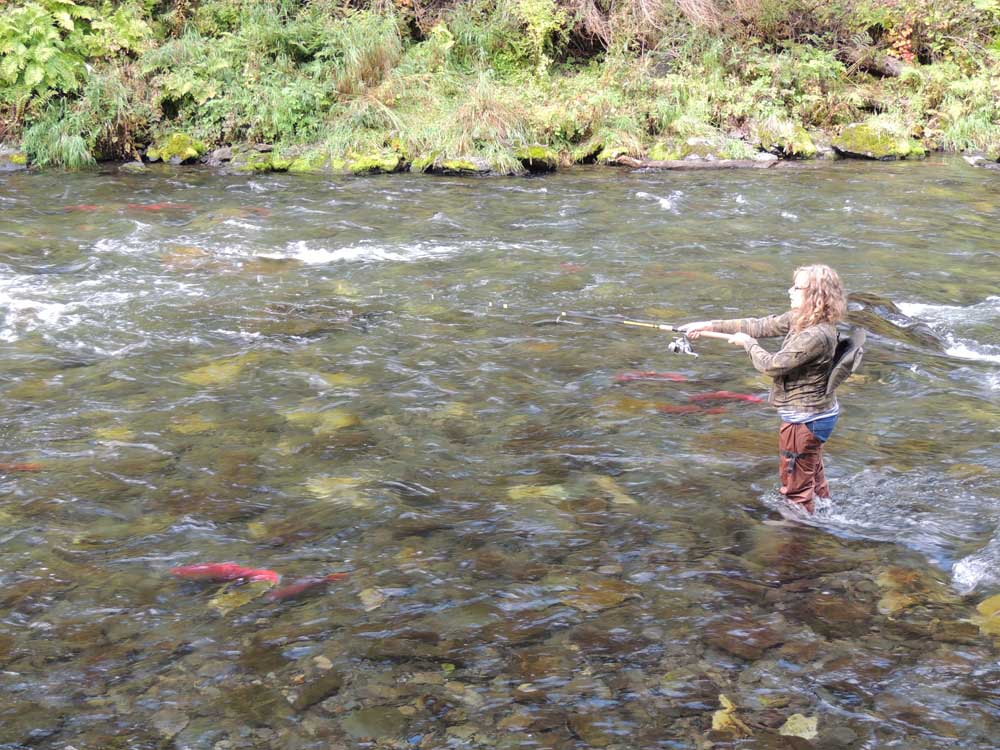Trout fishing during salmon spawning
Published 12:00 am Wednesday, October 29, 2014

- Gary Lewis / For The BulletinMikayla Lewis fishes for trout in a river full of salmon.
Way up the creek, we saw them, landlocked sockeye pulled tight into the banks to hide from the eagles. There were enough feathers along the banks to stock a headdress. We were in Oregon, hunting elk in primeval forest, but we could have been anywhere in the Pacific Northwest in any century in the last 5,000 years.
I supposed there were rainbows that preyed on salmon eggs, but they, like the kokanee, hid from eagles. These were landlocked salmon, but the bright reds and greens recalled to mind a similar scene on the Russian River a month before.
Even as my elk season wound down, I looked forward to fall fishing in Oregon and Washington, not unlike what we had in Alaska last month.
Going to Alaska in early September is like visiting autumn before it lands in the lower 48. We fished the Russian as the leaves on the vine maples turned yellow.
In bright reds and greens, the salmon were easy pickings for bears. We smelled old carcasses hauled out of the river and gave the bears a wide berth. The fish held our attention. It was easy to see the salmon and not so easy to see the trout. But the rainbows camouflaged in the rocks were our quarry.
The resident rainbows, some as fat as footballs, and seagoing steelhead ranged from 10 inches to 10 pounds. All were scarred from battle. They watched the salmon and waited for the next chance.
Every female salmon was attended by five or more males of the same species. The she-salmon, daughter of the great enchantress, made her choice of mates, and deposited her eggs in the gravel when the preferred male was close. It might happen as often as once a minute, and that’s when the rainbow, a scavenger undercover, made its move, flashing out from behind a boulder to seize the spawn.
In one section of stream we could see hundreds of colored-up sockeyes, pinks and silvers. In the margins were steelhead, rainbows and Dolly Varden. While the fish tried to stay out of one another’s way, make a living and pass on the gift of life, they had to watch for bears, bald eagles and fishermen.
For long minutes I watched with polarized glasses, my rod set against a tree. The trout held just out of the current, watching a hen salmon upstream. When she wiggled her tail, he moved with savage grace to eat the eggs. And then, almost as quick, a great hump-backed buck would slash at the trout and send him back to his hiding place.
One particular trout was about 14 inches long, a survivor. Scarred up and down his flanks by salmon teeth, I noticed he was also blind in one eye. He was so fixated on that one female sockeye’s eggs that if he saw an egg of another color, he ignored it. I know. I tried him.
Across the river and upstream, another angler had seemed to crack the code. He caught a rainbow about once every 10 minutes. But he was switching beads quite often, too, refining his presentation.
I had a box full of Hevi-Beads and had set up my dad and my daughter with the same style of presentation. Mikayla was first to land a fish on a bead in front of one of Dusty Harris’ orange egg flies. Dad netted a Dolly with a grapefruit-colored bead that had lost most of its finish.
Every salmon and trout species has a different color of egg, and the shades vary, too, by subspecies and ripeness. Some trout are drawn to fresher-looking spawn, whereas others seem to key on dead eggs. Adding a bit of marabou to the presentation can make all the difference.
Disgusted at my inability to catch that one-eyed trout, I rerigged with a flash orange Hevi-Bead, pinned by a band about 1½ inches above the hook. I then pulled some white marabou through the bead to simulate milt and stepped upstream to the next drift. On the first cast with the new bead, I caught a 16-inch rainbow, slashed and scarred like the one in the run below and blind in the same eye.
Fish in rivers with so much spawning activity can afford to be selective. A bead angler is well-armed with two dozen finishes and three or four sizes in each pattern. The presentation can be made just as well on fly gear as on a spinning setup. Most bead fishermen in Alaska use fly rods, but spinning rods work, too. In Oregon, glass and plastic beads are considered bait and are not legal on fly-fishing-only waters unless the bead is on the hook.
In many Western rivers, resident rainbows and steelhead pack on the protein feeding on salmon spawn. Some streams are well-suited to an angler with a box full of beads. With the right color combinations, the action can be fast-paced. In the low water, there is a good chance to watch, and take part in, the age-old battle.
— Gary Lewis is the host of “Frontier Unlimited TV” and author of “John Nosler — Going Ballistic,” “A Bear Hunter’s Guide to the Universe,” “Hunting Oregon” and other titles. Contact Lewis at www.GaryLewisOutdoors.com.






